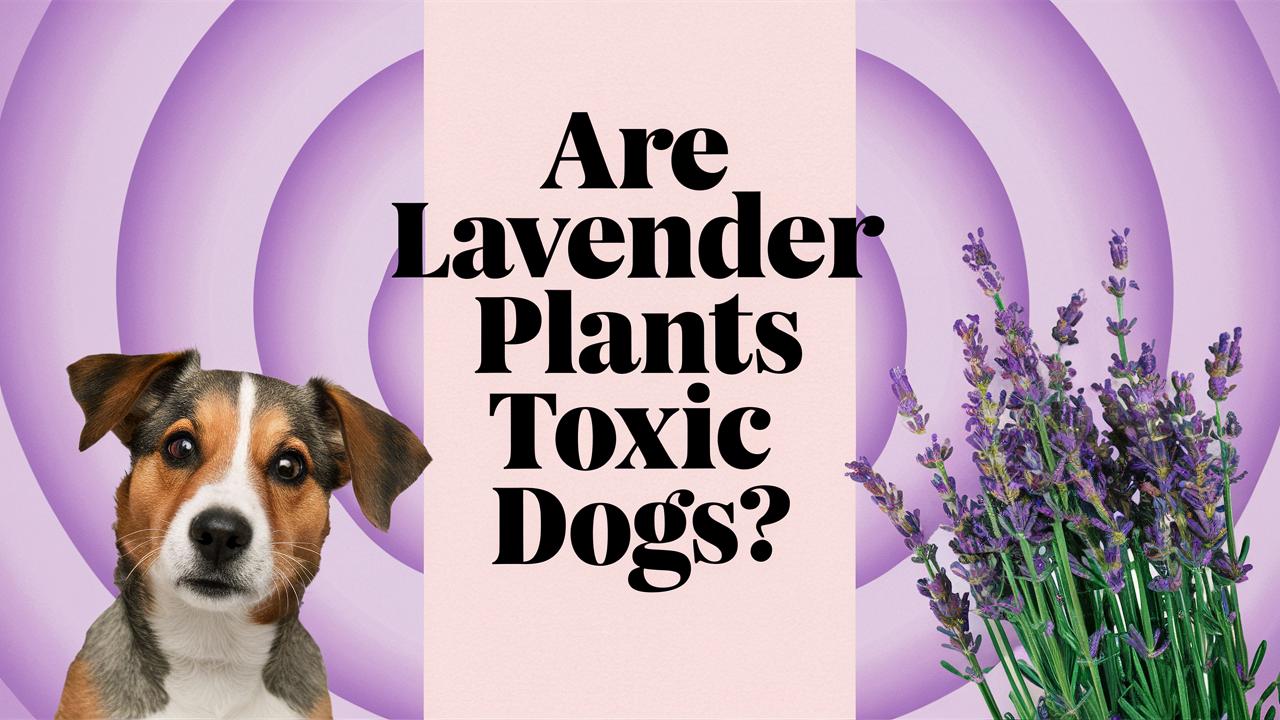In this guide, we’ll explore lavenders safety for our four-legged friends, explore its benefits, potential concerns, and offer tips for keeping your pets safe.
Understanding Lavender and Its Compounds

Before addressing the toxicity of lavender plants, it’s essential to understand what lavender is. The most common species, Lavandula angustifolia, is often used in essential oils and aromatherapy. Lavender contains several bioactive compounds, including linalool and linalyl acetate, which contribute to its characteristic scent and soothing properties.
The enjoyment of lavender is widespread, ranging from culinary uses in cookies and teas to appearances in skincare and aromatherapy. However, its effects on animals, specifically dogs, can vary and are crucial to understand for the well-being of our pets.
The Safety of Lavender for Dogs

Lavender and Its Effects: In small amounts, lavender is generally considered non-toxic to dogs. The ASPCA’s Animal Poison Control Center lists lavender as a plant that is not toxic to pets, which is reassuring news for dog owners who love gardening or using lavender in their homes. Many dogs may safely enjoy the aroma of lavender without any adverse effects, especially when inhaled.
Potential Reactions: While lavender is not toxic, individual dogs can have different sensitivities or allergies to plants and essential oils. Some dogs might experience mild gastrointestinal upset if they ingest lavender leaves or flowers, while others might have skin reactions to lavender oil. Signs of discomfort can include drooling, vomiting, or diarrhea. If you notice any of these symptoms after your dog has come into contact with or ingested lavender, it’s best to consult your veterinarian.
Why Do Dogs Eat Plants?

Understanding why dogs might be attracted to lavender or any plant can clarify how to manage and supervise their interactions with various flora. Dogs are naturally curious creatures, and many are inclined to explore their environment by smelling and tasting different leaves, flowers, and grasses.
Curiosity and Exploration
Dogs use their mouths to investigate the world, much like we use our hands. Their instinct to chew on plants is often driven by curiosity. The scent of lavender, being soothing and pleasant, might entice them even more.
Gastrointestinal Relief
Some dogs may nibble on grass or other plants out of instinctual behavior to alleviate stomach discomfort. If they find the taste of lavender appealing, they might consume it in hopes of soothing their belly.
Playfulness
Teenage or playful dogs are often prone to nibbling at plants as a form of play. The texture of lavender leaves can be intriguing, leading to playful chewing or gentle digging, if planted outdoors.
The Different Forms of Lavender

It’s important to note that lavender exists in various forms, from live plants in the garden to oil extracts in bottles. Each form has different implications for pet safety.
Lavender Plants
The physical lavender plant itself is generally safe for dogs to be around. Keeping your pet supervised when they are in close proximity to your garden can prevent accidental ingestion or digging up the plants.
Lavender Essential Oils
Lavender essential oil, while highly praised for its therapeutic properties in aromatherapy, poses more significant risks than the plant itself. Essential oils are concentrated extracts and can contain active compounds that may irritate a dog’s skin or digestive system. Dogs can be particularly sensitive to essential oils when used in diffusers or applied topically.
Lavender Sprays and Products
Many commercial products use lavender for its fragrance, including air fresheners, cleaning agents, and pet care products. As a pet owner, it’s crucial to check labels and avoid products with lavender essential oil if your dog is prone to sensitivities or allergies.
Signs of Lavender Poisoning

Although lavender is classified as non-toxic, it’s still important to be aware of potential symptoms your dog might exhibit if they have had an adverse reaction. Here are some signs to watch for:
Gastrointestinal Upset: Vomiting, diarrhea, or lack of appetite can indicate your dog might have ingested something that doesn’t agree with them.
Lethargy: If your dog seems unusually tired or weak, it could be a response to a mild reaction.
Skin Irritation: Redness, itching, or rash can occur if your dog has a sensitivity to lavender oil or concentrated products.
Excessive Salivation: Drooling can be a sign of nausea or an aversion to a particular taste.
In the event that your dog displays any of these symptoms, it’s best to contact your veterinarian for guidance.
Preventive Measures for Dog Owners

As a responsible pet owner, it’s important to proactively manage your dog’s interaction with lavender plants and related products. Here are some strategies to ensure their safety while still enjoying the beauty and scent of lavender.
Garden Placement
If you’re growing lavender in your garden, consider placing it in an area where your dog cannot easily access it. Raised beds or hanging planters can offer solutions to keep plants away from curious mouths.
Supervised Outdoor Time
When your dog is outdoors, supervise their interactions with any plants, especially if you’re unsure how they might behave. Redirect their attention with toys or other activities if they start nibbling on your lavender.
Educate Others
If you live with other people or have visitors, educate them about your dog’s habits and the potential risks associated with plants and products that may contain lavender. This helps ensure that your dog remains safe even when you’re not around.
Opt for Alternative Scents
If you’re utilizing lavender for its calming properties within your home, consider safer alternatives for dogs. Certain plants like rosemary, sage, or chamomile can offer similar aromatic benefits without the potential risks associated with lavender. Always confirm the safety of any new plants or essential oils before introducing them to your home.
The Calming Effects of Lavender on Dogs

Interestingly, while lavender can be harmful in concentrated forms, it may actually have calming effects on dogs when used properly. Its soothing aroma is known to relieve anxiety and promote relaxation. For this reason, many pet owners have explored safe ways to incorporate lavender into their routines.
Lavender for Anxiety Relief
Research has shown that the scent of lavender may have a calming effect not just on humans but also on dogs. Whether during a stressful event like a thunderstorm, fireworks, or travel, introducing lavender in moderate amounts—such as using a lavender-scented pillow spray on their bedding—can provide comfort.
Using Lavender in Dog Care Products
Numerous pet care products, such as shampoos and soothing sprays, now incorporate lavender in small, controlled doses. When selecting such products, always choose those specifically formulated for dogs to minimize the risk of irritation.
Creating a Calming Environment
Consider incorporating lavender in a dog-friendly environment by using distilled lavender water or low-concentration sprays on their bedding and toys. This not only contributes to a soothing atmosphere but can also help alleviate anxiety during stressful times.
Conclusion: Enjoy Lavender Safely
In summary, lavender plants are not considered toxic to dogs, which provides peace of mind for pet owners who adore this versatile herb. However, vigilance is essential when using lavender in various forms—particularly essential oils and concentrated products—as they can pose risks to our furry friends.





